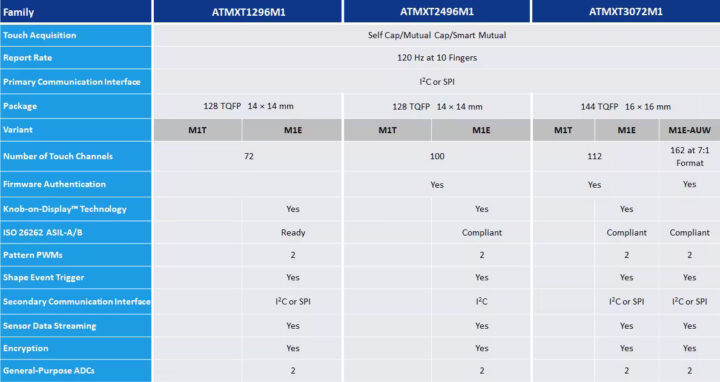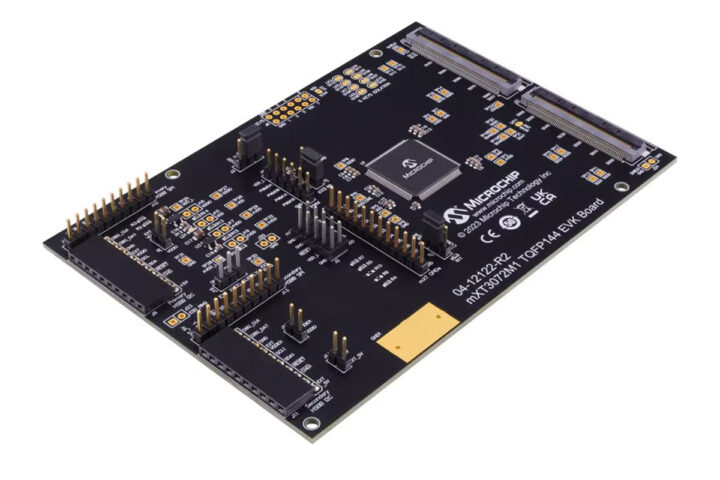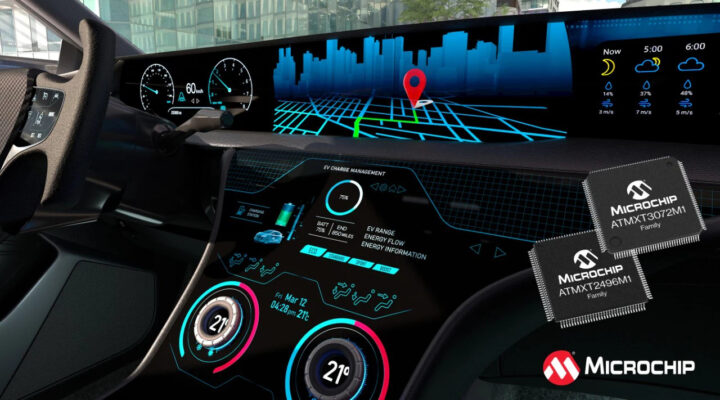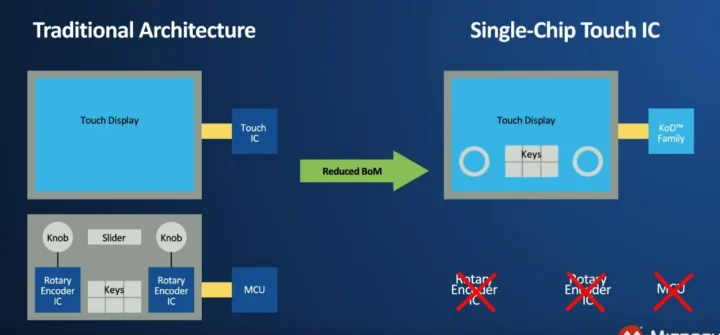Microchip Technology’s ATMXT3072M1 and ATMXT2496M1 add to the existing maXTouch M1 automotive touchscreen controllers and are designed for large, curved, free-form displays, including ones using OLED and microLED technologies.
These controllers support up to 112 reconfigurable touch channels (or 162 in ultra-wide mode), enabling touch functionality for displays up to 20-inch (16:9 format) or 34-inch (7:1 format) in size. Additionally, they use smart mutual touch acquisition to enhance signal-to-noise ratio (SNR) by +15 dB, ensuring reliable touch detection in high-capacitive environments. The controllers also feature integrated Knob-on-Display (KoD) technology for physical control knobs on touchscreens and low-latency haptic feedback for enhanced user interaction. The controls meet ASIL-A and B safety standards and support OTA firmware updates with SHA-512 authentication for cybersecurity compliance (ISO 21434:2021). All these features make these MCUs suitable for user-friendly infotainment and dashboard systems.
Microchip ATMXT3072M1 and ATMXT2496M1 specifications
- Touchscreen channels
- ATMXT3072M1 – 112 fully configurable sensor lines
- ATMXT2496M1 – 100 fully configurable sensor lines
- Touchscreen size
- ATMXT3072M1
- Up to 17.65″ (16:9 aspect ratio) with 5.5 mm sensor pitch
- Ultrawide mode (ATMXT3072M1E-AUW) – Up to 34″ (7:1 aspect ratio)
- ATMXT2496M1 – Up to 15.9″ (16:9 aspect ratio) with 5.5 mm sensor pitch
- ATMXT3072M1
- Multi-touch – Tracks up to 16 concurrent touches
- Touch sensing methods
- Mutual capacitance (Standard and Smart Mutual)
- Self-capacitance
- P2P Mutual Capacitance
- Touch performance
- Typical report rate – ≥120 Hz (10 touches)
- Initial touch latency – <25 ms
- Automatic touch sensor diagnostics
- Knob-on-Display (KoD) support
- Supports up to 4 knobs with up to 64 detents
- Configurable suppression area to prevent accidental touches
- Optional push/release function
- Noise suppression – Adaptive algorithms to counteract ambient and power-line noise
- Interfaces
- I²C (up to 3.4 MHz)
- SPI (up to 8 MHz)
- Debugging – SPI Interface
- Security
- Encrypted configuration and touch data
- Firmware authentication with SHA-512
- Power supply:
- Digital (Vdd) – 3.3V
- Analog (AVdd) – 3.3V
- High voltage drive (XVdd) – Up to 8.5V (Smart Mutual mode: 3.3V)
- Package options
- ATMXT3072M1 – 144-lead TQFP (16 × 16 × 1 mm, 0.4 mm pitch)
- ATMXT2496M1 – 128-lead TQFP (14 × 14 × 1 mm, 0.4 mm pitch)
- Operating temperature – -40°C to +105°C (AEC-Q100 Grade 2)

The company mentions that maXTouch M1 automotive touchscreen controllers support Smart Mutual Touch Acquisition and Knob-on-Display Technology. The Smart Mutual Touch Acquisition is a proprietary signal processing algorithm that increases the signal-to-noise ratio (SNR) by +15 dB, ensuring more reliable and accurate touch detection, even in high-noise automotive environments.

The touchscreen controllers also support Microchip’s unique KoD feature, enabling physical knobs to be placed on capacitive touchscreens, which is rare in other touchscreen development kits. It removes the need for rotary encoder ICs and additional MCU since everything is handled by the touchscreen controller. You can check out a KoD demo and better understand how it works in the video embedded below using previous-generation KoD touch controllers.
The chips comply with CISPR 25 Class 5 standards for electromagnetic interference (EMI) suppression, Both controllers feature ISO 26262 ASIL-A/B compliance, providing functional safety mechanisms such as real-time touch sensor diagnostics and fault detection. Additionally, these controllers support encrypted touch data and configuration parameters, along with SHA-512 firmware authentication. The embedded Error Correcting Code (ECC) in flash memory further enhances reliability by preventing data corruption.
To make the development process fast and simple, the company designed the EV01S50A development board based on the ATMXT3072M1 touchscreen controller and a 15.6” ITO touch sensor. The development board is open-sourced and you can get the schematic and design files from the documentation section of its products page. It can be programmed with the free maXTouch Studio LITE Integrated Development Platform (IDP) available for Windows.

At the time of writing, the ATMXT2496M1 is said to be in production. The ATMXT3072M1, on the other hand, is labeled as a future product and doesn’t have a price tag or release date. However, you can already purchase the ATMXT3072M1-based EV01S50A dev board from the Microchip store for $150. Additional information about the maXTouch M1 controllers can be found on the products page and in the press release.
Debashis Das is a technical content writer and embedded engineer with over five years of experience in the industry. With expertise in Embedded C, PCB Design, and SEO optimization, he effectively blends difficult technical topics with clear communication
Support CNX Software! Donate via cryptocurrencies, become a Patron on Patreon, or purchase goods on Amazon or Aliexpress






